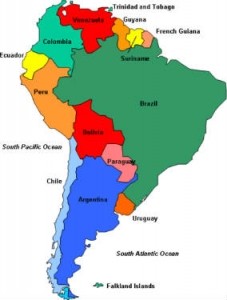Credit and debit card payments account for the vast majority of the United States’ online purchases, particularly with the introduction of contactless payments. However, this doesn’t ring true for the rest of the globe.

In fact, card issuers such as Visa and Mastercard only account for 23% of e-commerce payments worldwide, while local payment methods (LPMs), those payment methods outside of traditional card payments that facilitate the different needs of global geographies (such as bank transfers and e-wallets) account for 43% of global e-commerce transactions.
In 2019, 55% of worldwide online transactions are set to be based on local payment methods and this figure is expected to increase further to 80%. It is clear that there are a number of influencing commerce markets which must be on the ‘watch list’ of merchants and Payment Service Providers during 2019 to ensure upcoming trends and the impact they are set to make can be fully capitalized on.
Let’s dive into this year’s commerce trends across top regions around the world.
Europe
Strong Customer Authentication (SCA) under the Second Payment Service Directive (PSD2)

Europe, one of the most influential markets in the cross-border e-commerce space, is making big moves to address the imbalance of security versus convenience to tackle fraud issues that exist among online transactions. The introduction of Strong Customer Authentication (SCA) under the Second Payment Service Directive (PSD2) in September 2019 is central to this. The SCA requires two independent authentication elements to verify transactions.
SCA will apply to online payments within the European Union (or EU) – and will have consequences for most companies doing business online in Europe. As a result, many EU-based merchants will need to make significant changes to payment flows.

To make sure their payment processes are compliant, merchants will need to incorporate two of the following mandatory methods of authentication for online payments to verify a customer’s identity; something that only the customer:
- Knows, such as a PIN or the answer to a security question.
- has or possesses, for example, a mobile phone or hardware token.
- Is using biometrics including fingerprint, facial recognition or iris scan.
In recent years, fraud has grown so much that nearly 1 in 60 online transactions attempted globally are fraudulent. For businesses, it’s estimated that, when not addressed properly, fraud can cost up to 3% of their revenue.
LPMs such as SOFORT, which is available in several EU countries; Bancontact in Belgium or iDEAL in the Netherlands, already rely on Multi-Factor Authentication (MFA) by asking customers to login using their credentials and a one-time password, which is sent by test or generated in real-time.
Contactless Payments

The chip-and-pin was introduced to payment cards in 2006, making the method now over 12 years old. Since it was introduced, there has been a reduction in fraud on counterfeit cards. Contactless payments ride on the same rails as EMV, the standard for credit cards (developed and managed by American Express, Discover, JCB, Mastercard, UnionPay and Visa) that uses computer chips to authenticate card-based payments. This allows customers to pay quickly and easily by simply tapping and/or waving their card near the terminal.
The contactless payments trend is growing quickly in regions like Europe, Australia, Brazil and Canada. In fact, in 2018 contactless payments overtook in store cash payments for the first time at 52%.
However, in the US, the situation is the opposite. Many merchants already have terminals that can accept contactless payments — they just haven’t enabled the technology yet. But as customers increasingly demand faster transaction times, it’s likely that merchants will soon begin rolling out contactless cards. Banks need to be thinking now about what their strategy will be for getting these cards into their customers’ hands.
Africa

Africa is set to be the next e-commerce revolution; 2019 is the year to start making this rapidly expanding market a priority. This continent is home to over a billion people across 54 countries, and during the 21st century, it has seen a remarkable industrial transformation. This young and high-growth region is at the cutting-edge of global consumer behavior, without the burden of entrenched distribution channels or legacy infrastructure for entrants to overcome – much like China.
Africa also has one of the fastest growing middle-class consumer markets in the world. Their buying power is significant, and they are driving demand for content on mobile platforms. The explosion in mobile usage is not only important from a consumer perspective, but it’s also extending into payments innovation.
Nearly 60% of the world’s active mobile money accounts are in Sub-Saharan Africa alone, according to Ecobank Research. M-Pesa, a mobile phone-based money transfer service, has been hugely successful in Kenya and this is expected to be replicated across the board for mobility payments in Africa. 2019 is going to be an instrumental year for this frontier market.
Latin America

In Latin America, connectivity is fueling rapid e-commerce growth. The region’s biggest e-commerce market – Brazil – is a global digital power within its own right. Latest trends indicate m-commerce and social media are still the best way to reach consumers. Most importantly, local payment methods are the key to success, with many consumers foregoing international credit cards in place of local credit cards, contactless debit transactions and Boletos (bank and cash).
While Brazil is expected to continue to lead the region in 2019 and for the foreseeable future, Argentina is also one to watch closely. The country is coming off the back of remarkably strong e-commerce and m-commerce performances.
While Argentina has experienced economic tensions in recent years, it has benefited from high internet penetration rates and sees the largest mobile Internet usage in Latin America. It also has the largest middle-class in the region, with high spending power. It is highly likely digital banks will prevail and some of the cash-based methods, like Pago Facil and Rapipago, will give into more mobile and digital payments.
South East Asia

South E
Major investment boosts from Chinese companies Alibaba and Tencent have now paved the way for a big year in e-commerce across the region.
In particular, Indonesia is one to watch with the market primed to grow rapidly. With swift GDP growth and the fastest growing number of Internet users across the globe, Indonesia is ripe for e-commerce.
Quick to establish itself as a mobile-first nation, it presents a unique opportunity for merchants to introduce digital platforms to further engage tech savvy and motivated consumers. By 2025, Southeast Asia’s digital economy is predicted to triple to $240 billion, with Indonesia’s digital market to account for nearly half of that. This would put the nation third in the region, behind Asian powerhouse markets such as China and India.
One of the biggest challenges for e-commerce in Indonesia has been the low penetration of debit and credit cards. However, there continues to be great potential for LPMs such as CIMB Clicks (bank transfer), mandiri clickpay (bank transfer), Alfamart (cash based) and Indomaret (cash based), as consumers continue to demonstrate their willingness to pay and shop online.

Guest post by Ronnie D’Arienzo, Chief Revenue Officer at PPRO Group

